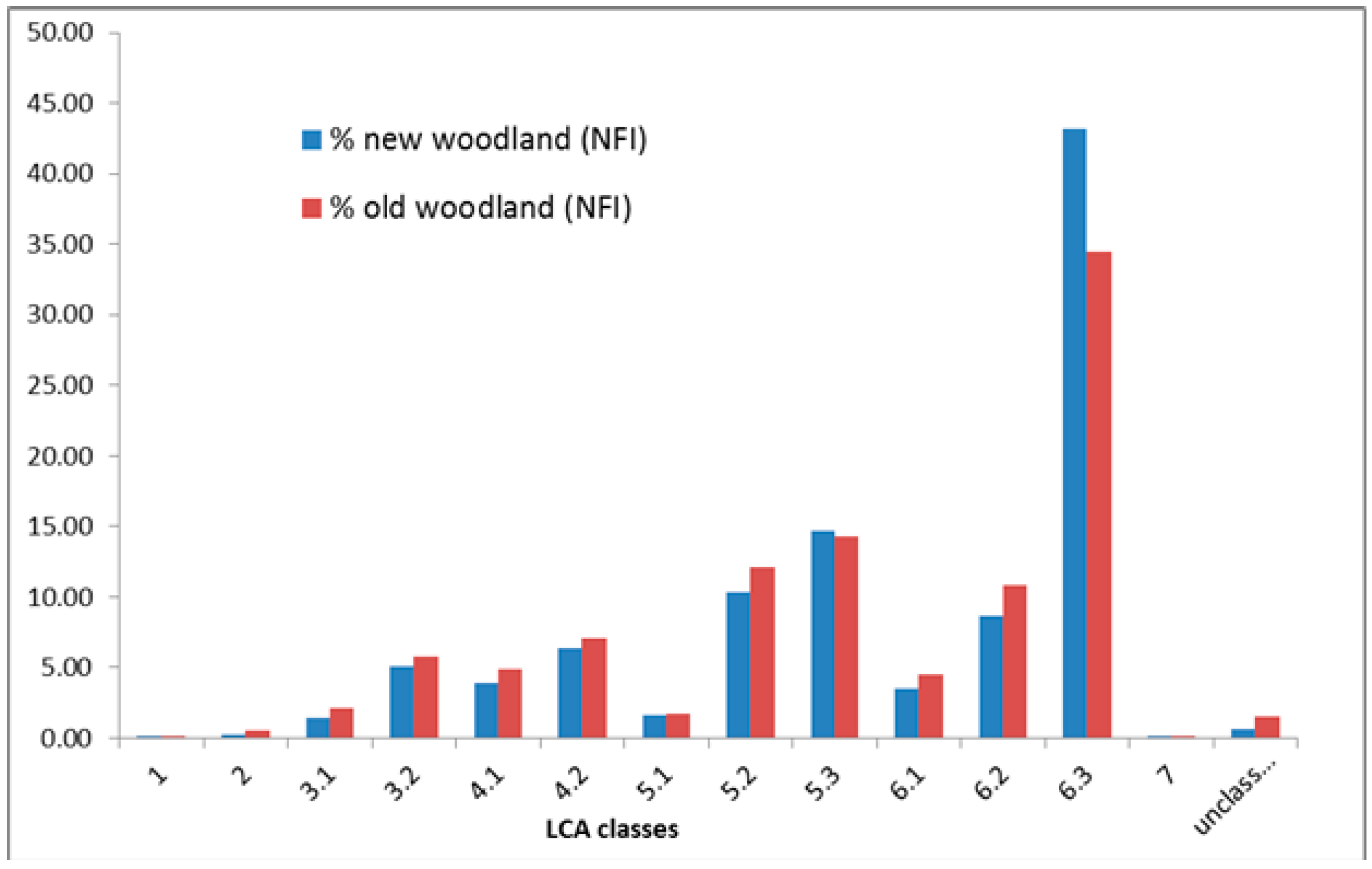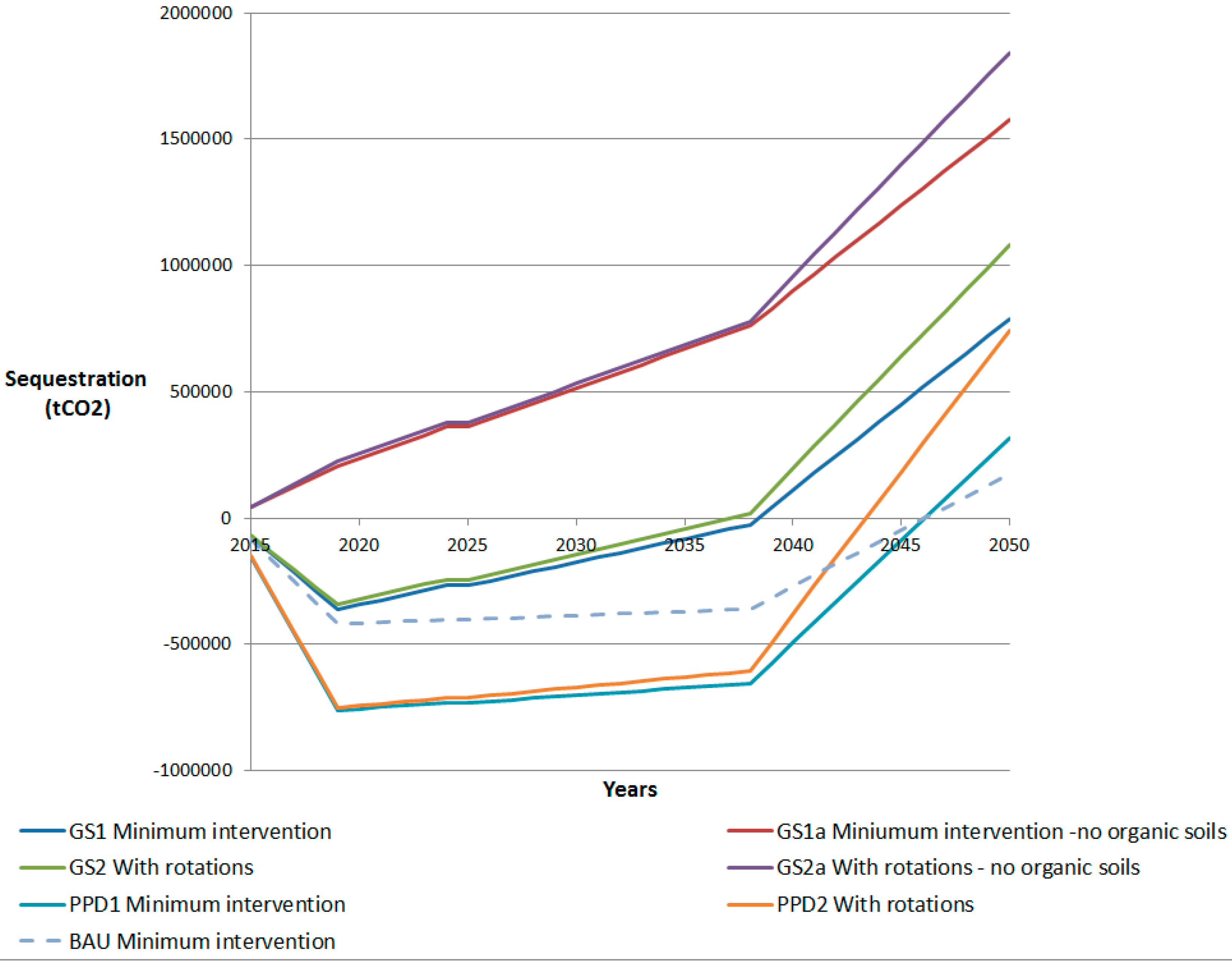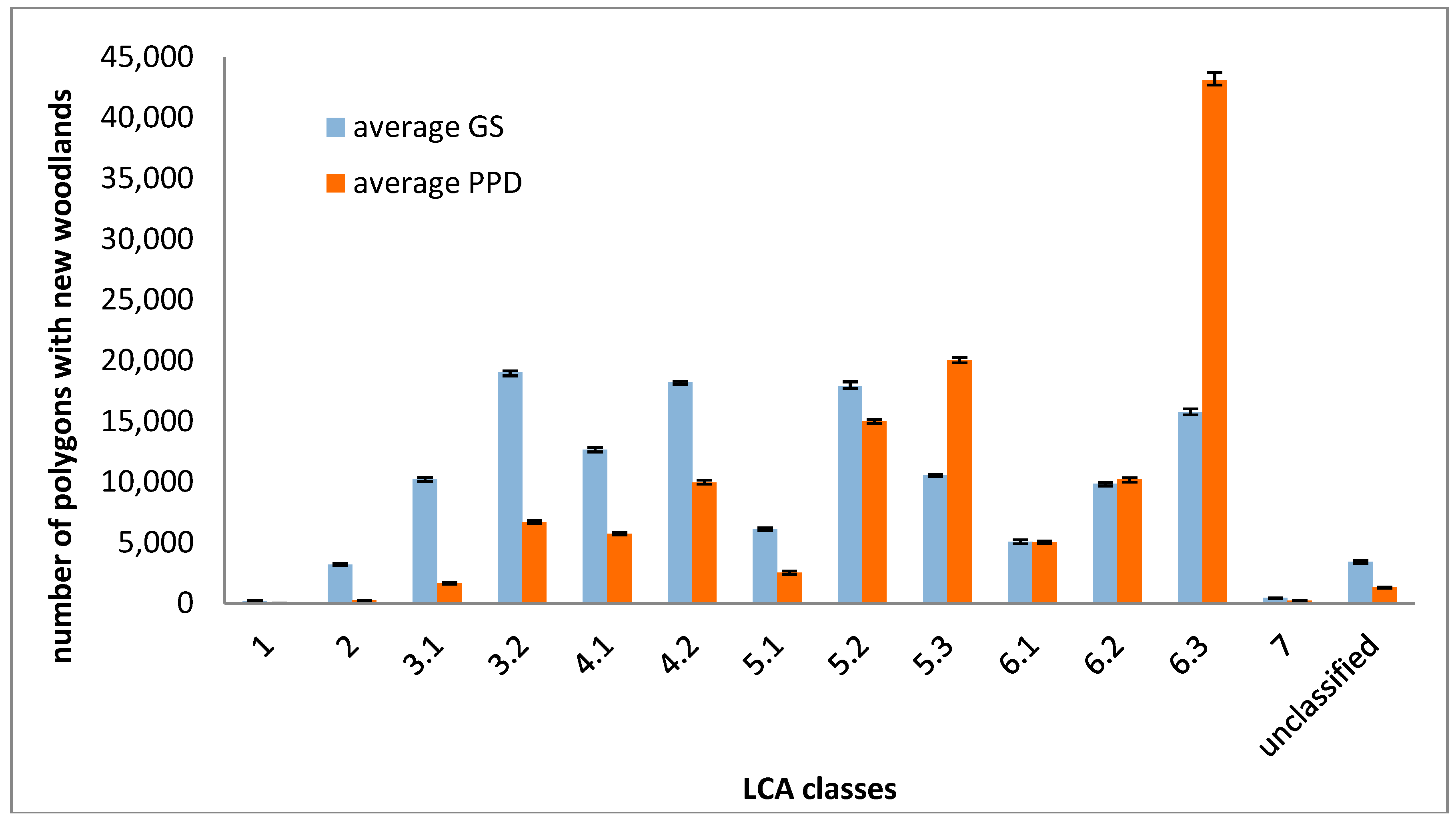Comparing Path Dependence and Spatial Targeting of Land Use in Implementing Climate Change Responses
Abstract
:1. Introduction
1.1. Land Use and Climate Change Policy
1.2. Path Dependence
2. Case Study Background
| Class | Category | Climate Limitations | Maximum Land Use Potential (Higher Classes Can Also be Used as for Lower Classes) |
|---|---|---|---|
| Class 1 | Prime | None or very minor | Very wide range of crops with consistently high yields |
| Class 2 | Prime | Minor | Wide range of crops, except those harvested in winter |
| Class 31 | Prime | Moderate | Moderate range of crops, with good yields for some (cereals and grass) and moderate yields for others (potatoes, field beans, other vegetables) |
| Class 32 | Non-Prime | Moderate | Moderate range of crops, with average production, but potentially high yields of barley, oats and grass |
| Class 41 | Non-Prime | Moderately-severe | Narrow of crops, especially grass due to high yields but harvesting may be restricted due to wetness factors |
| Class 42 | Non-Prime | Moderately-severe | Narrow range of crops, especially grass due to high yields but harvesting may be severely restricted due to wetness factors |
| Class 51 | Non-Prime | Severe | Improved grassland (mechanical intervention possible) low soil wetness restrictions |
| Class 52 | Non-Prime | Severe | Improved grassland (mechanical intervention possible): medium soil wetness restrictions |
| Class 53 | Non-Prime | Severe | Improved grassland (mechanical intervention possible): severe soil wetness restrictions |
| Class 61 | Non-Prime | Very Severe | Rough grazing pasture only—good grazing quality |
| Class 62 | Non-Prime | Very Severe | Rough grazing pasture only—medium grazing quality |
| Class 63 | Non-Prime | Very Severe | Rough grazing pasture only—poor grazing quality |
| Class 7 | Non-Prime | Extremely Severe | Very limited agricultural value |

3. Data and Methods
3.1. Soils and Land Capability Data
3.2. Recent Land Use Trends
3.3. Future Scenarios
- (i)
- Business as Usual (BAU)
- (ii)
- Policy with Path Dependent behavior (PPD)
- (iii)
- Global Sustainability (GS)
3.4. Net GHG emissions from Land Use Change
- Upland-type afforestation exemplified by Yield Class 12 m3∙ha−1∙yr−1 (YC12) Sitka spruce on peaty gley soils (Table 2). These peaty gley soils are widespread in the uncultivated Scottish uplands and have acid and poorly drained characteristics with relatively high carbon stocks. Reported values for carbon fluxes and GHG emissions from afforestation of organic and organo-mineral soils vary widely and appear to show considerable spatial and temporal heterogeneity associated with a range of factors including the level of disturbance from drainage and ground preparation [42,43,44,45]. Using the indicative values provided by Morison et al. [41] allows large-scale generalization for interpretation in a policy context.
- Lowland-type afforestation on grassland exemplified by Yield Class 4 m3∙ha−1∙yr−1 (YC4) oak on brown earth soils (Table 3). Brown earth soils are well drained soils with high levels of natural fertility and they mainly occur in the warmer and drier lowlands of eastern Scotland where they are often cultivated as arable land or improved grassland. As lowland afforestation can also include conversion from arable land then the rates for grassland conversion from Morison et al. [41] were also modified (Table 4) based on the meta-analysis of net LULUCF soil emissions of Dawson and Smith [46] by adding a default increment to represent additional sequestration potential on arable soils after establishment (2.2 t∙CO2∙ha−1∙yr−1).
| Type | Establishment (0–5 years) | Initial (5–25 years) | Full Vigor (25–60 years) | Full Source |
|---|---|---|---|---|
| Min intervention | −23.0 | −0.5 | 9.5 | ([41]: Table 5.12b) |
| 35 yr rotation managed with standard thinning and felling | −23.0 | −0.2 | 13.7* | ([41]: Table 5.13b) |
| Type | Establishment (0–5 years) | Initial (5–35 years) | Full Vigour (35–60 years) | Full Source |
|---|---|---|---|---|
| Min intervention | 8.1 | 3.3 | 4.9 | ([41]: Table A8.3b) |
| 80 yr rotation managed with standard thinning and felling | 8.8 | 3.9 | 6.3 | ([41]: Table 8.4b) |
| Type | Establishment (0–5 years) | Initial (5–35 years) | Full Vigour (25–60 years) | Full Source |
|---|---|---|---|---|
| Min intervention | 8.1 | 5.5 | 6.1 | Table 3 modified using [46] |
| 80 yr rotation managed with standard thinning and felling | 8.8 | 6.1 | 8.5 | Table 3 modified using [46] |
3.5. Habitat Patches
4. Results
4.1. Current Land Use Trends

4.2. Future Scenarios

4.3. Net GHG Emissions from Land Use Change

| Scenario Variant | Total Net Sequestration by 2050 (Mt CO2e) |
|---|---|
| BAU Minimum intervention | −9.47 |
| PPD1 Minimum intervention | −17.21 |
| PPD2 With rotations | −13.58 |
| GS1 Minimum intervention | 0.32 |
| GS1a Minimum intervention—mineral soils only | 24.40 |
| GS2 With rotations | 3.12 |
| GS2a With rotations—mineral soils only | 26.62 |
4.4. Habitat Patches

5. Discussion
5.1. Interpretation of Recent Trends
5.2. Implications of Future Scenarios
5.3. Further Work
6. Conclusions
Acknowledgments
Author Contributions
Conflicts of Interest
References
- Lambin, E.F.; Turner, B.L.; Geist, H.J.; Agbola, S.B.; Angelsen, A.; Bruce, J.W. The causes of land-use and land-cover change: Moving beyond the myths. Glob. Environ. Chang. 2001, 11, 261–269. [Google Scholar] [CrossRef]
- Wilson, G.A. From productivism to post-productivism and back again? Exploring the unchanged natural and mental landscapes of European agriculture. Trans. Inst. Br. Geogr. 2001, 26, 77–102. [Google Scholar] [CrossRef]
- Bohnet, I. Assessing retrospective and prospective landscape change through the development of social profiles of landholders: A tool for improving land use planning and policy formulation. Landsc. Urban Plan. 2008, 88, 1–11. [Google Scholar] [CrossRef]
- Bürgi, M.; Hersperger, A.M.; Schneeberger, N. Driving forces of landscape change—Current and new directions. Landsc. Ecol. 2004, 19, 857–868. [Google Scholar] [CrossRef]
- Lambin, E.F.; Meyfroidt, P. Land use transitions: Socio-ecological feedback versus socio-economic change. Land Use Policy 2011, 27, 108–118. [Google Scholar]
- Read, D.J.; Freer-Smith, P.H.; Morison, J.I.L.; Hanley, N.; West, C.C.; Snowdon, P. Combating Climate Change—A role for UK Forests. An Assessment of the Potential of UK’s Trees and Woodlands to Mitigate and Adapt to Climate Change; The Stationery Office: Edinburgh, UK, 2009; p. 222. [Google Scholar]
- Misselbrook, T.H.; Cape, J.N.; Cardenas, L.M.; Chadwick, D.R.; Dragostis, U.; Hobbs, P.J.; Nemitz, E.; Reis, S.; Skiba, U.; Sutton, M.A. Key unknowns in estimating atmospheric emissions from UK land management. Atmos. Environ. 2010, 45, 1067–1074. [Google Scholar] [CrossRef]
- Feliciano, D.; Slee, B.; Hunter, C.; Smith, P. Estimating the contribution of rural land-uses to greenhouse gas emissions: A case study of North East Scotland. Environ. Sci. Policy 2013, 25, 36–49. [Google Scholar]
- Röder, M.; Thornley, P.; Campbell, G.; Bows-Larkin, A. Emissions associated with meeting the future global wheat demand: A case study of UK production under climate change constraints. Environ. Sci. Policy 2014, 39, 13–24. [Google Scholar] [CrossRef]
- The Royal Society of Edinburgh (RSE). Facing Up to Climate Change: Breaking the Barriers to a Low-Carbon Scotland; RSE: Edinburgh, UK, 2011. [Google Scholar]
- Swart, R.J.; Raes, F. Making integration of adaptation and mitigation work: Mainstreaming into sustainable development policies? Clim. Policy 2007, 7, 288–303. [Google Scholar]
- Goklany, I. Integrated strategies to reduce vulnerablity and advance adaptation, mitigation, and sustainable development. Mitig. Adapt. Strateg. Glob. Chang. 2007, 12, 755–786. [Google Scholar] [CrossRef]
- Biesbroek, R.; Swart, R. The mitigation-adaptation dichotomy and the role of spatial planning. Habitat Int. 2009, 33, 230–237. [Google Scholar] [CrossRef]
- Wynne-Jones, S. Carbon blinkers and policy blindness: The difficulties of “Growing our woodland in Wales”. Land Use Policy 2013, 32, 250–260. [Google Scholar]
- Feliciano, D.; Hunter, C.; Slee, B.; Smith, P. Selecting land-based mitigation practices to reduce GHG emissions from the rural land use sector: A case study of North East Scotland. J. Environ. Manag. 2013, 120, 93–104. [Google Scholar] [CrossRef]
- Brown, I.; Castellazzi, M. Scenario analysis for regional decision-making on sustainable multifunctional land uses. Reg. Environ. Chang. 2014, 14, 1357–1371. [Google Scholar] [CrossRef]
- Nelson, R.R.; Winter, S.G. An Evolutionary Theory of Economic Change; Harvard University Press: Cambridge, MA, USA, 1982. [Google Scholar]
- Martin, R.; Sunley, P. Path dependence and regional economic evolution. J. Econ. Geogr. 2006, 6, 395–437. [Google Scholar] [CrossRef]
- Chhetri, N.B.; Easterling, W.E.; Terando, A.; Mearns, L. Modeling path dependence in agricultural adaptation to climate variability and change. Ann. Assoc. Am. Geogr. 2010, 100, 894–907. [Google Scholar] [CrossRef]
- Slee, B.; Brown, I.; Donnelly, D.; Gordon, I.; Matthews, K.; Towers, W. The squeezed middle: Evaluating options for intermediate quality land in Scotland. Land Use Policy 2014, in press. [Google Scholar]
- Angus, A.; Burgess, P.J.; Morris, J.; Lingard, J. Agriculture and land use: Demand for and supply of agricultural commodities, characteristics of the farming and food industries, and implications for land use in the UK. Land Use Policy 2009, 26, S230–S242. [Google Scholar] [CrossRef]
- Lawrence, A.; Dandy, N. Private landowners’ approaches to planting and managing forests in the UK: What’s the evidence? Land Use Policy 2014, 36, 351–360. [Google Scholar]
- Pan, D.; Domon, G.; de Blois, S.; Bouchard, A. Temporal (1958–1993) and spatial patterns of land use changes in Haut-Saint- Laurent (Quebec, Canada) and their relation to landscape physical attributes. Landsc. Ecol. 1999, 14, 35–52. [Google Scholar] [CrossRef]
- Malcolm, H.; Moxley, J.; Buys, G.; Hallsworth, S.; Thomson, A. Projections to 2050 of Emissions and Removals from the LULUCF Sector in Scotland, England, Wales and Northern Ireland; Report for the Department of Energy and Climate Change (DECC): London, UK, 2014.
- Scottish Government. Getting the Best from Our Land: A Land Use Strategy for Scotland; APS Group Scotland: Edinburgh, UK, 2010.
- Scottish Government. Low Carbon Scotland: Meeting the Emissions Reduction Targets 2011–2022; The Report on Proposals and Policies; Scottish Government: Edinburgh, UK, 2011.
- Scottish Government. Climate Change Delivery Plan: Meeting Scotland’s Statutory Targets; Scottish Government: Edinburgh, UK, 2009.
- Woodland Expansion Advisory Group. Report to the Scottish Government. 2012. Available online: http://scotland.forestry.gov.uk/images/corporate/pdf/WEAGFinalReport.pdf (accessed on 1 May 2014). [Google Scholar]
- Bibby, J.S.; Douglas, H.A.; Thomasson, A.J.; Robertson, J.S. Land Capability Classification for Agriculture; Macaulay Land-use Research Institute: Aberdeen, UK, 1982. [Google Scholar]
- Brown, I.; Towers, W.; Rivington, M.; Black, H.I.J. Influence of climate change on agricultural land-use potential: Adapting and updating the land capability system for Scotland. Clim. Res. 2008, 37, 43–57. [Google Scholar] [CrossRef]
- Brown, I.; Poggio, L.; Gimona, A.; Castellazzi, M.S. Climate change, drought risk and land capability for agriculture: Implications for land-use policy in Scotland. Reg. Environ. Chang. 2011, 11, 503–518. [Google Scholar]
- National Forest Inventory (NFI) 2012. Available online: http://www.forestry.gov.uk/inventory (accessed on 5 May 2014).
- Pohl, C. From science to policy through transdisciplinary research. Environ. Sci. Policy 2008, 11, 46–53. [Google Scholar] [CrossRef]
- Godet, M. Scenarios and Strategic Management; Butterworth: London, UK, 1987. [Google Scholar]
- Houet, T.; Loveland, T.R.; Hubert-Moy, L.; Gaucherel, C.; Napton, D.; Barnes, C.A.; Sayler, K. Exploring subtle land use and land cover changes: A framework for future landscape studies. Landsc. Ecol. 2010, 25, 249–266. [Google Scholar] [CrossRef] [Green Version]
- Scotland’s Soils: Soil Maps and Data. Available online: http://www.soils-scotland.gov.uk/data/ (accessed on 7 May 2014).
- Morton, D.; Rowland, C.; Wood, C.; Meek, L.; Marston, C.; Smith, G.; Wadsworth, R.; Simpson, I.C. Final Report for LCM2007—The New UK Land Cover Map. Report of CEH Project Number: C03259. 2011. Available online: http://www.ceh.ac.uk/documents/lcm2007finalreport.pdf (accessed on 22 July 2014).
- Castellazzi, M.S.; Matthews, J.; Angevin, F.; Sausse, C.; Wood, G.A.; Burgess, P.J.; Brown, I.; Conrad, K.F.; Perry, J.N. Simulation scenarios of spatio-temporal arrangement of crops at the landscape scale. Environ. Model. Softw. 2010, 25, 1881–1889. [Google Scholar] [CrossRef]
- Intergovernmental Panel on Climate Change (IPCC). Available online: http://www.ipcc-nggip.iges.or.jp/public/2006gl/index.html (accessed on 2 May 2014).
- Hillier, J.; Walter, C.; Malin, D.; Garcia-Suarez, T.; Canals, L.; Smith, P. A farm-focused calculator for emissions from crop and livestock production. Environ. Model. Softw. 2011, 26, 1070–1078. [Google Scholar] [CrossRef]
- Morison, J.I.L.; Matthews, R.; Miller, G.; Perks, M.; Randle, T.; Vanguelova, E.; White, M.; Yamulki, S. Understanding the Carbon and Greenhouse Gas Balance of Forests in Britain; Forestry Commission Research Report 18; 2012; p. 149. Available online: http://www.forestry.gov.uk/pdf/FCRP018.pdf/$FILE/FCRP018.pdf (accessed on 21 July 2014).
- Minkkinen, K.; Laine, J. Long-term effect of forest drainage on the peat carbon stores of pine mires in Finland. Can. J. For. Res. 1998, 28, 1267–1275. [Google Scholar]
- Hargreaves, K.J.; Milne, R.; Cannell, M.G.R. Carbon balance of afforested peatland in Scotland. Forestry 2003, 76, 299–317. [Google Scholar] [CrossRef]
- Reynolds, B. Implications of changing from grazed or semi-natural vegetation to forestry for carbon stores and fluxes in upland organo-mineral soils in the UK. Hydrol. Earth Syst. Sci. 2007, 11, 61–76. [Google Scholar] [CrossRef]
- Morison, J.; Vanguelova, E.I.; Broadmeadow, S.; Perks, M.; Yamulki, S.; Randle, T. Understanding the GHG Implications of Forestry on Peat Soils in Scotland; The Research Agency of Forestry Commission: London, UK, 2010. Available online: http://www.forestry.gov.uk/forestry_peat_GHG./FCS_forestry_peat_GHG_final_Oct13_2010.pdf (accessed on 6 May 2014).
- Dawson, J.J.C.; Smith, P. Carbon losses from soil and its consequences for land-use management. Sci. Total Environ. 2007, 382, 165–190. [Google Scholar] [CrossRef] [PubMed]
- Edwards, P.N.; Christie, J.M. Yield Models for Forest Management; Forestry Commission Booklet: London, UK, 1981.
- McGarigal, K.; Cushman, S.A.; Neel, M.C.; Ene, E. FRAGSTATS: Spatial Pattern Analysis Program for Categorical Maps. Available online: www.umass.edu/landeco/research/fragstats/fragstats.html (accessed on 5 May 2014).
- Crabtree, B.; Chalmers, N.; Eiser, D. Voluntary incentive schemes for farm forestry: Uptake, policy effectiveness and employment impacts. Forestry 2001, 74, 455–465. [Google Scholar] [CrossRef]
- Munton, R. Rural land ownership in the United Kingdom: Changing patterns and future possibilities for land use. Land Use Policy 2009, 26, S54–S61. [Google Scholar] [CrossRef]
- Slee, B.; Feliciano, D.; Nijnik, M.; Pajot, G. The scope of the land-based sector to mitigate climate change in North-East Scotland: Opportunities and challenges with particular reference to the role of forests. Int. J. Environ. Sustain. Dev. 2012, 11, 274–292. [Google Scholar] [CrossRef]
- Kahneman, D.; Tversky, A. Choices, values, and frames. Am. Psychol. 1984, 39, 341–350. [Google Scholar] [CrossRef]
- Ilbery, B.; Maye, D.; Watts, D.; Holloway, L. Property matters: Agricultural restructuring and changing landlord–tenant relationships in England. Geoforum 2010, 41, 423–434. [Google Scholar] [CrossRef]
- Burton, R. See through the “good farmer’s” eyes: Towards developing an understanding of the social symbolic value of productivist behaviour. Sociol. Rural. 2004, 44, 195. [Google Scholar]
- Burton, R.J.F.; Kuczera, C.; Schwarz, G. Exploring farmers’ cultural resistance to voluntary agri-environmental schemes. Sociol. Rural. 2008, 48, 16–37. [Google Scholar]
- Schirmer, J.; Bull, L. Assessing the likelihood of widespread landholder adoption of afforestation and reforestation projects. Glob. Environ. Chang. 2014, 24, 306–320. [Google Scholar]
- Laiho, R. Decomposition in peatlands: Reconciling seemingly contrasting results on the impacts of lowered water levels. Soil Biol. Biochem. 2006, 38, 2011–2024. [Google Scholar] [CrossRef]
- Nijnik, M.; Pajot, G.; Moffat, A.; Slee, B. An economic analysis of the establishment of forest plantations in the United Kingdom to mitigate climatic change. For. Policy Econ. 2013, 26, 34–42. [Google Scholar]
- Kahle, H.-P. Causes and Consequences of Recent Forest Growth Trends in Europe; European Forest Institute: Joensuu, Finland, 2008. Available online: http://www.efi.int/portal/virtual_library/publications/research_”reports/21/ (accessed on 6 May 2014).
- Green, S.; Hendry, S.J.; Redfern, D.B. Drought damage to pole-stage Sitka spruce and other conifers in North-East Scotland. Scott. For. 2008, 62, 10–18. [Google Scholar]
- Glynn, M.; Richardson, W.; Anable, J.; Quick, T.; Rowcroft, P.; Smith, S. Independent Panel on Forestry Woodland Owner Survey; Final Report to the Independent Panel on Forestry; URS Corporation: London, UK, 2012. [Google Scholar]
- Broadmeadow, M.; Matthews, R. Forests, Carbon and Climate Change: The UK Contribution. Information Note 48; Forestry Commission: Edinburgh, UK, 2003.
- Lozada-Vasquez, L.M. Co-Operation and Co-Ordination for Landscape Scale Conservation. Ph.D. Thesis, University of Birmingham, West Midlands, UK, 2012. [Google Scholar]
- Elands, B.H.M.; Praestholm, S. Landowners’ perspectives on the rural future and the role of forests across Europe. J. Rural. Stud. 2008, 24, 72–85. [Google Scholar]
- Ellison, D.; Lundblad, M.; Petersson, H. Carbon accounting and the climate politics of forestry. Environ. Sci. Policy 2011, 14, 1062–1078. [Google Scholar] [CrossRef]
- Smith, J.; Gottschalk, P.; Bellarby, J.; Chapman, S.; Lilly, A.; Towers, W.; Bell, J.; Coleman, K.; Nayak, D.; Richards, M.; et al. Estimating changes in Scottish soil carbon stocks using ECOSSE. II: Application. Clim. Res. 2010, 45, 193–205. [Google Scholar] [CrossRef]
- Bell, M.; Cloy, J.M.; Rees, R.M. The true extent of agriculture’s contribution to national greenhouse gas emissions. Environ. Sci. Policy 2014, 39, 1–12. [Google Scholar] [CrossRef]
- Worrall, F.; Bell, M.J.; Bhogal, A. Assessing the probability of carbon and greenhouse gas benefit from the management of peat soils. Sci. Total Environ. 2010, 13, 2657–2666. [Google Scholar] [CrossRef]
- Van Kooten, G.C.; Shaikh, S.L.; Suchanek, P. Mitigating climate change by planting trees: The transaction costs trap. Land Econ. 2002, 78, 559–572. [Google Scholar] [CrossRef]
- Turner, B.L., II; Janetos, A.C.; Verburg, P.H.; Murray, A.T. Land system architecture: Using land systems to adapt and mitigate global environmental change. Glob. Environ. Chang. 2013, 23, 395–397. [Google Scholar] [CrossRef]
© 2014 by the authors; licensee MDPI, Basel, Switzerland. This article is an open access article distributed under the terms and conditions of the Creative Commons Attribution license (http://creativecommons.org/licenses/by/3.0/).
Share and Cite
Brown, I.; Castellazzi, M.; Feliciano, D. Comparing Path Dependence and Spatial Targeting of Land Use in Implementing Climate Change Responses. Land 2014, 3, 850-873. https://doi.org/10.3390/land3030850
Brown I, Castellazzi M, Feliciano D. Comparing Path Dependence and Spatial Targeting of Land Use in Implementing Climate Change Responses. Land. 2014; 3(3):850-873. https://doi.org/10.3390/land3030850
Chicago/Turabian StyleBrown, Iain, Marie Castellazzi, and Diana Feliciano. 2014. "Comparing Path Dependence and Spatial Targeting of Land Use in Implementing Climate Change Responses" Land 3, no. 3: 850-873. https://doi.org/10.3390/land3030850
APA StyleBrown, I., Castellazzi, M., & Feliciano, D. (2014). Comparing Path Dependence and Spatial Targeting of Land Use in Implementing Climate Change Responses. Land, 3(3), 850-873. https://doi.org/10.3390/land3030850




